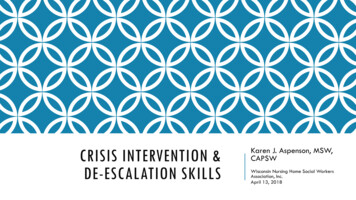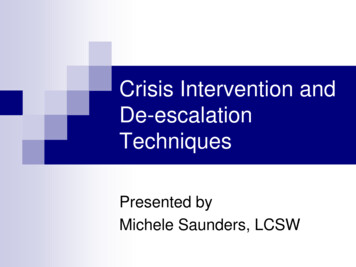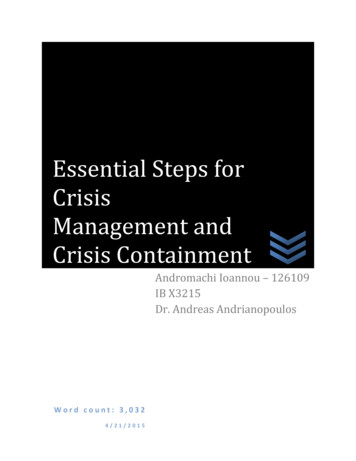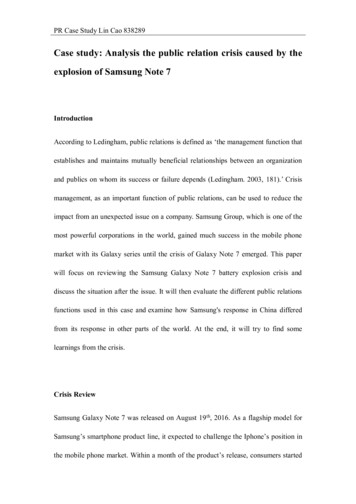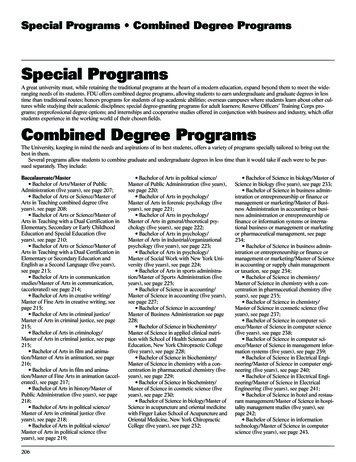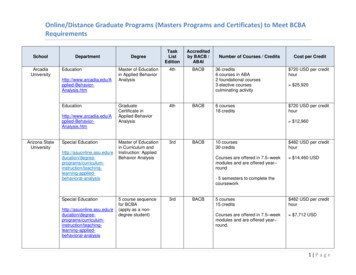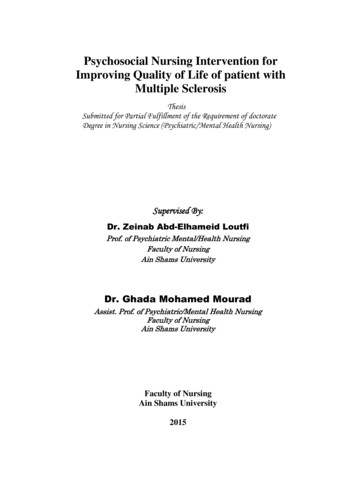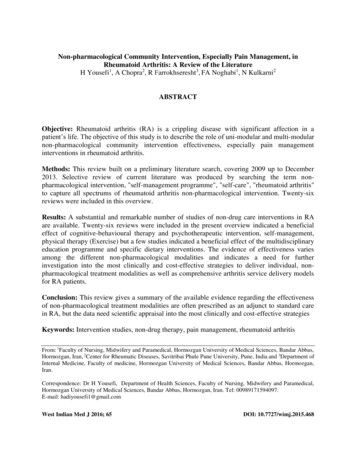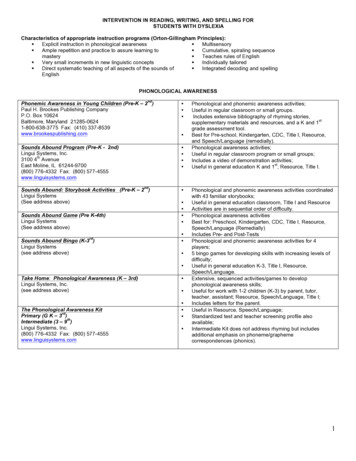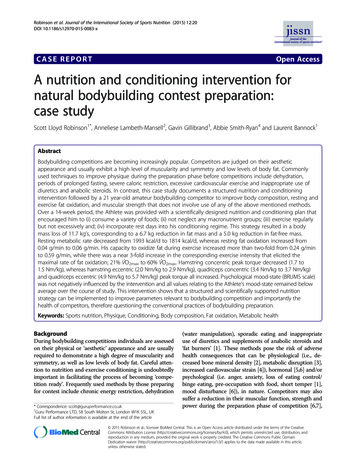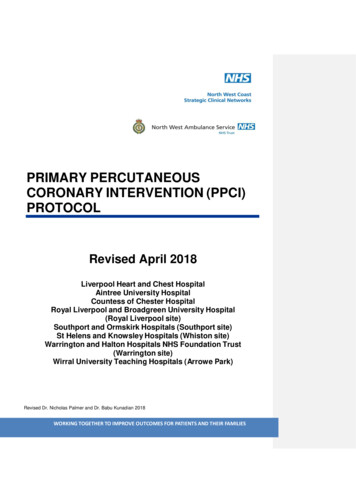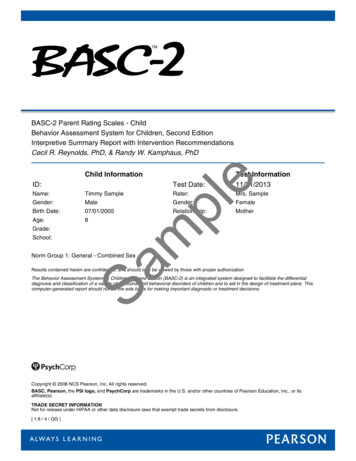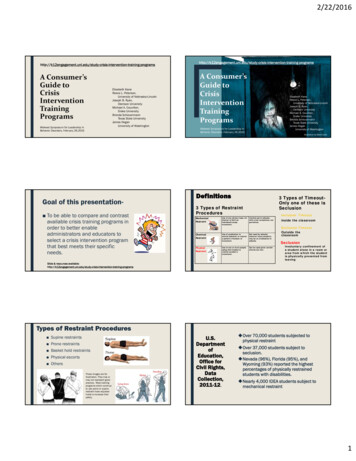
Transcription
-intervention-training-programsA Consumer’sGuide toCrisisInterventionTrainingProgramsMidwest Symposium for Leadership InBehavior Disorders, February 26,2016Elisabeth KaneReece L. Peterson,University of Nebraska-LincolnJoseph B. Ryan,Clemson UniversityMichael A. Couvillon,Drake UniversityBrenda ScheuermannTexas State UniversityJames HoganUniversity of WashingtonGoal of this presentation To be able to compare and contrastavailable crisis training programs inorder to better enableadministrators and educators toselect a crisis intervention programthat best meets their risis-intervention-training-programsA Consumer’sGuide toCrisisInterventionTrainingProgramsElisabeth KaneReece L. Peterson,University of Nebraska-LincolnJoseph B. Ryan,Clemson UniversityMichael A. Couvillon,Drake UniversityBrenda ScheuermannTexas State UniversityJames HoganUniversity of WashingtonMidwest Symposium for Leadership InBehavior Disorders, February 26,2016Illustration by Ward ZwartDefinitions3 Types of TimeoutOnly one of these isSeclusion3 Types of RestraintProceduresMechanicalRestraintUse of any device (tape, tiedowns) to limit anindividual’s bodymovement.Limited use in schools;with a few exceptions, notpermitted.ChemicalRestraintUse of medication tocontrol behavior or restricta patient’s freedom ofmovementNot used by schools;however many studentsmay be on medication inschools.PhysicalRestraintUse of one or more peopleusing their bodies torestrict another’smovement.Can be used given certaincriteria are met.Inclusion Timeoutinside the classroomExclusion TimeoutOutside theclassroomSeclusionInvoluntary confinement ofa student alone in a room orarea from which the studentis physically prevented fromleaving4Slide & resources s-intervention-training-programsTypes of Restraint Procedures Supine restraints Prone restraints Basket hold restraints Physical escorts OthersThese images are forillustration. They may ormay not represent goodpractice. Most trainingprograms which continueto use prone or supinerestraint have adjustedholds to increase theirsafety.U.S.DepartmentofEducation,Office forCivil Rights,DataCollection,2011-12. Over 70,000 students subjected tophysical restraint Over 37,000 students subject toseclusion. Nevada (96%), Florida (95%), andWyoming (93%) reported the highestpercentages of physically restrainedstudents with disabilities. Nearly 4,000 IDEA students subject tomechanical restraint1
2/22/2016Of studentssubjected torestraint, 75%were studentswith adisability.Office of Civil Rights2014 ReportOf studentssubjected toseclusion58% werestudentswith adisabilityOffice of CivilRights 2014ReportU.S. Department of Education, Office for Civil Rights, Civil Rights Data Collection, 2011-12.U.S. Department of Education, Office for Civil Rights, Civil Rights Data Collection, 2011-12STRONG ADVOCACY CONTINUES!H.R. 927Some states - policy activity.The Keeping All StudentsSafe ActMassachusetts, Virginia & Washington , Nebraska – recent examplesThe bill in the House hasbeen re-introduced; noaction and none likely.How Safe Is The SchoolhouseJESSICA BUTLER. UPDATED JULY 25, 2015 An updated guide to staterestraint and seclusion laws, regulations, rules and policies in effect as of July25, 2015; SSA - Every Student Succeeds Act‘‘(1) DESCRIPTIONS .—Each State plan shall describe— .‘‘(C) how the State educational agencywill support local educational agencies receiving assistance under this part to improve schoolconditions for student learning, including through reducing— ‘‘(i) incidences of bullying andharassment; ‘‘(ii) the overuse of discipline practices that remove students from the classroom; and‘‘(iii) the use of aversive behavioral interventions that compromise student health and safety;“ p.41-42 of pdfTwo previous studies of the content ofcrisis intervention programs Farrell and Cubit (2005) covered contentof training for aggression managementtraining programs intended for nursesand others in mental health settings. Farrell and Cubit compared andcontrasted how 28 programs traindiverse components, such as, levels ofrisk, communication, physical restraint,seclusion, debriefing, etc. They concluded most programs includedinformation on personal safety for staffand clients, and recommended refreshercourses. However they did not discusspsychological costs. Only 7 trainedrestraint, and only 1 discussed the risksof restraints. Couvillon, Peterson, Ryan,Scheuermann, and Stegall (2010),surveyed similar content topics fortraining delivered to schools.Purposes the of present study Need for Couvillon et al. (2010) Update in context of:– Policy changes– Increased safety concerns The study found that the average rangebasic training length was 12 to 16hours, but varied greatly, and variedbased on level of training.– To also address seclusion They also found substantial variation inthe emphasis put on major topics oftraining (e.g., conflict de-escalationversus restraint procedures).– Address lack of consensus for content & focus– Highlight major similarities and differences– Aid consumers on purchasing decisions2
2/22/2016The Present StudyTraining Vendors Questions were refined with amix of both closed and openended responses. When completed it included 99questions Options created for electronic(Qualtrics) or hard copy ortelephone interview completion.Management of Aggressive Behavior (MOAB)MOAB Training International, Inc.moabtraining.comNonviolent Crisis Intervention ProgramCrisis Prevention Institutecrisisprevention.comOregon Intervention System (OIS)Alternative Service, Inc. - Oregonois.asioregon.orgPMTPMT Associates, Inc.pmtassociates.netPro-ACT Pro-ACT, Inc.proacttraining.com Only those providing training on restraints were included.Professional Crisis ManagementProfessional Crisis Management Associationpcma.com 32 Initially identified, but 7 were no longer in businessResponseResponse Training Program LLCresponsetrainings.comRight ResponseService Alternatives Training Instituterightresponse.orgSafe and Positive Approaches Devereuxdevereux.orgSafe Crisis ManagementJKM Training Incorporatedjkmtraining.com Result was data from 17 vendors- 68% of total.Safe Prevention Principle and TechniquesJIREH Training and Consulting LLCjirehtraining.com Owner or lead trainer was contacted and asked tocomplete the questionnaire.Safety-CareQBS, Inc.qbscompanies.comSatori Alternatives to Managing Aggression (SAMA)Satori Learning Designs, Inc.mandtsystem.comThe Mandt SystemThe Mandt System, Inc.mandtsystem.comTherapeutic Aggression Control Techniques (TACT2)SBP Consulting, Inc.tact2.comTherapeutic Crisis Intervention (TCI)Residential Child Care Project, Cornell Univ.rccp.cornell.edu/tcimainpage.html Effort to identify all current training vendors providingtraining to schools through Internet searches andnominations. Of the remaining 25, 6 declined or did not respond, twodid not complete the questionnaire. Once completed the data was sent back to the vendorfor verification. General information anddefinitionsRespondentswere asked for% of trainingallocated toeach Restraint procedures Dangers and Risks Crisis De-escalationprocedures Procedures for monitoring Debriefing and follow up Seclusion Other topic areas* Interpretations may vary based on differing terminology or understandings; use only for gross comparisonsAverage Allocation Across Training ProgramsMonitoringProcedures, p.comTrainingcontent by 8globalcomponents*Seclusion, 2Devriefing &Follow-up, 6Organization NameCrisis Consultant Group, LLC.Questionnaire The Couvillon, et al.questionnaire was obtained,expanded and organized into10 content sections or topics.17 Crisis Intervention TrainingProgramsOther, 11GeneralInformation/Definitions, 8Dangers &Risks, 6Crisis Deescalation, 41Calm Every Storm, Crisis Intervention TrainingAllocation of resources across general topicsTraining Program NameCalm Every StormMOABNonviolent CrisisIntervention programOISPMTPro-ACT Professional CrisisManagementResponseRIGHT RESPONSESafe & Positive Approaches Safe Crisis ManagementSafe Prevention Principlesand TechniquesSafety-CareSAMAThe Mandt System TACT2TCITotal BasicGeneralDangersCrisisRestraintMonitoring Debriefing Seclusion Other TotalTraining Information/ & Risks De-escalation Procedures Procedures & Follow-up%%%TimeDefinitions %%%%%%16 hrs6-8 hrs5205155520152051055555510010014 hrs12 hrs8 hrs20 90510010010010014 hrs12 hrs5-14 hrs14 hrs18 00000122529010010010010010016-20 hrs12 hrs16 hrs19 hrs18-20 hrs28-32 55155172.51050012.5003535000100100100100100100Pie charts of all of the vendor training programs are providedto illustrate variations in time allocations across all eighttopics. We pick a few as examples in discussing content topics.Selected topics to discuss today: Seclusion and Other Crisis De-escalation procedures Restraint procedures Monitoring procedures De-briefing procedures3
2/22/2016“Other” TopicsSeclusion Most training programs don’t includecomponents on seclusion– Only 8 discuss & 4 train Component interpretations vary When included in basic training, noprogram spent more than 5% ofoverall time on seclusion; range 1-5% Many adaptions, extensions, orcombinations of othercomponents When comparing allocations of timethis may explain some variation. Topics included: protectiontechniques, incident prevention,mental health, trauma,relationships, leverage, anddeflection and releasetechniques, etc. Account for unique trainingaspectsSatoriGeneral Information/Definitions1%Alternativesto ManagingAggressionSafety-CareOther35%Dangers &Risks5%Seclusion0%Other35%Debriefing &Follow-up1% MonitoringProcedures1%General Information/Definitions5%Dangers & Risks2%Crisis Deescalation40%RestraintProcedures20%Crisis De-escalationProceduresCrisis Deescalation25% On average, biggest emphasisacross programsSeclusion0%Debriefing &Follow-up5% MonitoringProcedures5%The Mandt SystemDebriefing & Follow-up7%MonitoringProcedures7% 2/3 of the programs spend themost time on crisis de-escalation– Recognize signs of agitation– Identify and manage antecedents– Assess contributing factorsRestraintProcedures20%Seclusion1%General Information/Definitions7%Dangers &Risks8%SeclusionManagementDebriefing & 0%RestraintProcedures12%Crisis Deescalation58%RestraintProcedures20%Dangers &Risks15%Crisis Deescalation20%4
2/22/2016Types of Restraint ProceduresTraining Related to Restraint Procedures Due to heightened risk, it takes a certain amount of time to teach physical holds adequately Programs moving towards using “holds” versus “restraint” for political correctness Programs coin terms and have special names for holds, spend time teaching this terminology Some populations may need more focus on restraint Many programs have moved away from prone (face down) or supine (face up) holdsThese images are for illustration. They may or may not represent good practice. Most programs which continueto use types of prone or supine restraints have adjusted these to increase their safety. The % of overall time allocated to training onholds ranged from 8% to 50% Most programs dedicate between 12% -25%of their time to restraint procedures; themean was 21% The number of different types of holds trainedranged from 2 to 27 Specific Types of holds:– 4 of the 17 programs trained basket holds, 23.5%– 8 of the 17 programs trained prone restraints, 47%– 9 of the 17 programs trained supine holds, 53%Restraint Procedures TaughtProfessional Crisis ManagementTypes ofRestraints (#)PhysicalEscortsBasket HoldRestraintProne FloorRestraintSupine sYesNoYesNoYesNoYesNoNoYesYesYesNoNoYesYesSafe Prevention Principles and Techniques8Safety-CareSAMAThe Mandt SystemTACT2Therapeutic Crisis sYesNoNoNoYes---YesNoNoYesYesTraining Program NameCalm Every StormMOABNonviolent Crisis Intervention programOISPMTPro-ACT Professional Crisis ManagementResponseRIGHT RESPONSESafe & Positive Approaches Safe Crisis ManagementMonitoringProcedures, 5GeneralInformation/Definitions, 20Seclusion, 0Dangers &Risks, 5General Information/Definitions10%Dangers &Risks5%RestraintProcedures50%Crisis lent Crisis InterventionDebriefing &Follow-up, 10Debriefing &Follow-up5%Seclusion0%Seclusion3%Debriefing &Follow-up8%MonitoringProcedures7%Other5%General Information/Definitions5%Dangers &Risks4%RestraintProcedures8%RestraintProcedures, 25Crisis Deescalation, 35Crisis Deescalation60%5
2/22/2016Monitoring All teach techniques for monitoring a student’sphysical and emotional state All instruct how to identify signs of physicaldistress. Crucial to actively monitor the breathing rates ofstudents placed in a restraint 14 programs actively teach participants to monitorbreathing rate On average, relatively less time is spent (TACT-2)Debriefing &follow-upMonitoring 3%Procedures2%Seclusion3%General Information/Definitions 10%SeclusionManagementDebriefing & 5%ofFollow-upAggressive5%Behavior(MOAB)Dangers &Risks15%RestraintProcedures20% Physical restraintprocedures can result inemotional distress for allinvolvedDangers &Risks2% Majority of the programsprograms teachparticipants how todebrief or follow upSafe Prevention Principles & s15%Crisis Deescalation20%De-Briefing May include: assessingemotional state, problemsolving, & documentationCrisis s30%Debriefing 10%Dangers &Risks12%Crisis 9%Seclusion2%Debriefing & Follow-up2%MonitoringProcedures ions15%Dangers & Risks10%Crisis De-escalation25%6
2/22/2016ConclusionsCertification/lengths of training All certify Certification takes on 18 hours on average for basictraining ; range 12 – 28 Re-certification or annual update; on average 7 hours;range 3 – 20 hours Training of trainer; varied requirements– Related experience– Career in related field– Related degree, etc.A Consumers Guide: Identify your purposeIdentify target personnel for trainingIdentify population & setting of clients/students servingIdentify length of time required for certification for that vendorChoose a training program based on the emphases which meetsyour needsWe did not examine or compare costsConsider whether special tailoring is desired (add componentson seclusion, etc.)Consider whether a trainer of trainer model is appropriateConsider whether you need just non-physical training Reminder that these are gross estimates & may be more complicatedthan they appear Training is evolving and will continue to evolve Policy is impacting training General movement away from more extreme holds or ones that havecaused most danger (e.g. use of prone & supine have decreased) Larger programs accommodate/alter their content for differentpopulations/audience/organizations A lot of the training is pretty similar but with different names - Matter ofterminology – coining terms and time is spent learning those words,and also political correctness terminology (now using holds)QUESTIONS? is-intervention-training-programs Elisabeth KaneUniversity of Nebraska-Lincolnelisabethjkane@gmail.com Reece L. Peterson, Ph.D.ResearchCollaboratorsUniversity of Nebraska-Lincolnrpeterson1@unl.edu Joseph M. Ryan, Ph.D.Clemson University Michael Couvillon, Ph.D.Drake University Brenda Scheuermann, Ph.D.Texas State University, San Marcos James HoganUniversity of WashingtonCalm Every StormDebriefing &Follow-up, 5Seclusion, 540PMTDebriefing &Other, 5Dangers & Risks,5MonitoringProcedures, 5Monitoring Follow-upProcedures ngers , 15Crisis Deescalation, 55Crisis Deescalation40%7
2/22/2016Right ResponseResponseDangers &Risks2%General Information/Definitions2%Debriefing &Follow-up4%Other25%Crisis Deescalation31%Debriefing res30%Seclusion0%General Information/Definitions 4%Dangers & Risks is Deescalation58%Seclusion0%Safe & Positive ApproachesSafe Crisis ManagementDebriefing &Monitoring Follow-upProcedures10%5%Other12%General Information/Definitions 5%Dangers & Risks 5%Other29%DangersGeneral& Risks Information/De7%finitions5%Seclusion0%Debriefing &Follow-up4%RestraintProcedures30%Crisis Deescalation45%Debriefing & Therapeutic MonitoringProceduresCrisisIntervention 5%(TCI)Crisis ation/Definitions5%Dangers gProcedures3%Slides and pie charts for 17 training programs are available vention-training-programsThe EndCrisis Deescalation50%8
Safe and Positive Approaches Devereux devereux.org Safe Crisis Management JKM Training Incorporated jkmtraining.com Safe Prevention Principle and Techniques JIREH Training and Consulting LLC jirehtraining.com Safety-Care QBS, Inc. qbscompanies.com Satori Alternatives to Managing Aggres
